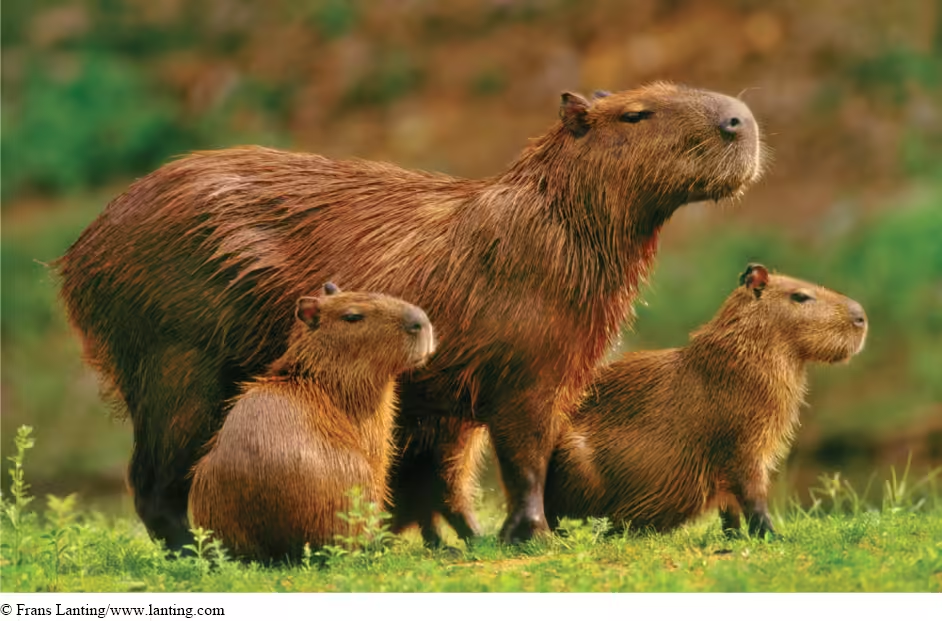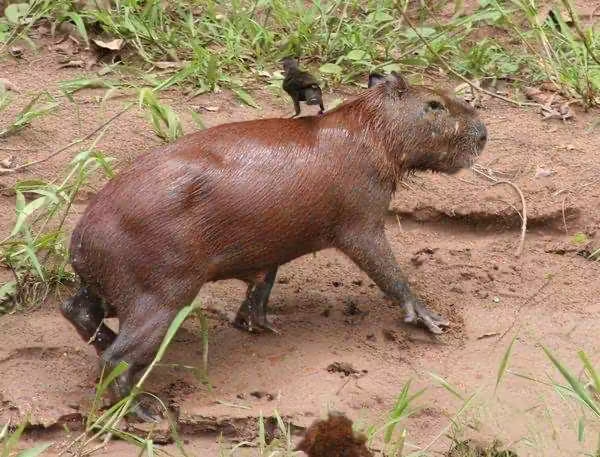Capybaras go through amazing physical and behavioral changes as they age. From birth to old age, these semi-aquatic mammals show a captivating journey of growth and development. Knowing about their lifespan and aging process helps us understand their unique adaptations.
Key Takeaways
- Capybaras are the world’s largest rodents, weighing 35-66 kg and up to 0.6 meters tall.
- They have a lifespan of 6-10 years in the wild and up to 12 years in captivity.
- Capybaras undergo significant physical and behavioral changes as they age, from their barrel-shaped, sturdy build to their semi-aquatic adaptations.
- Understanding the capybara’s aging process provides valuable insights into this unique species’ remarkable adaptations.
- Their habitat and environmental factors influence the capybara’s lifespan and aging characteristics.
Infant Stage (Birth to 1 Year)
Capybara infants, or pups, can stand and walk soon after birth. They start eating plants within a week. Pups nurse for about 16 weeks and may get milk from several females.
Juvenile Development (1-2 Years)
At around 1 year old, capybaras start to leave their parents’ group. This stage is when they learn important physical and social skills. It prepares them for adulthood.
Adult Life Stage (2+ Years)
Adult capybaras reach sexual maturity between 7-24 months, depending on gender. They show different behaviors and physical traits. They form groups, breed, and show a sense of hierarchy and territory.
Knowing the capybara life stages helps us understand these amazing rodents better. As they grow, capybaras change a lot in their behavior. These changes affect how they interact with their environment and each other.
Physical Characteristics From Birth to Adulthood
Capybaras, the world’s largest rodents, change a lot as they grow. Newborn capybaras weigh about 1,500 grams (3.3 lbs) and have all their teeth. By 18 months, they weigh around 40 kg (88 lbs).
As capybaras get older, they can grow even more. Adults usually weigh between 35 to 66 kg (77 to 145 lbs). The biggest capybaras were found in southern Brazil, weighing up to 91 kg (200 lbs). They are about 1070 to 1340 mm (3.5 to 4.4 ft) long, from head to body.
These changes show how strong and adaptable capybaras are. As they grow, they develop traits that help them live well in their homes.
Early Development Milestones
The capybara, a semi-aquatic mammal, grows and matures fascinatingly. From birth, they start a journey of fast physical and social growth. Knowing the early life milestones of capybaras helps us understand their aging process.
Nursing and Weaning Period
Capybara young nurse for about 16 weeks, showing their mother’s care. Soon after birth, they start eating grass, showing they can adapt to their semi-aquatic home. Capybara herds often have many females nursing the young, building a strong community.
Social Integration
As capybara pups grow, they join small groups in the herd. This social integration is key to their development, as they learn survival skills from others. At first, they stay away from water, fearing predators, but soon get used to it.
Physical Coordination Development
The physical skills of capybara improve quickly. They can keep up with their mothers and graze within a week. This shows their ability to move well in their semi-aquatic home from a young age.
By looking at a capybara’s early development, we see their amazing resilience and adaptability. From nursing to social integration and physical skills, their growth is truly captivating.
How Capybaras Age: Changes in Behavior and Physical Traits as They Grow Older
Capybaras change a lot as they grow up. Their behavior and looks change a lot. These changes help us understand how they grow and adapt to their world.
When they’re young, capybara pups need their moms and the group to survive. As they get older, they start to do things on their own. They help defend their territory and work together to breed.
As they get to be adults, capybaras get bigger. Females are usually a bit bigger than males. Their fur might change color or texture too.
The way capybaras live together also changes as they get older. Older, stronger ones often lead the group. They help decide what to do and how to act.
| Behavior Changes | Physical Trait Changes |
|---|---|
|
|
It’s important to know about changes in behavior and physical traits as capybaras grow older. This helps us understand their whole life cycle and how they adapt. It also helps us care for them better and appreciate their capybara behavior changes over time.
Sexual Maturity and Reproductive Changes
Capybaras, the world’s largest rodents, go through big changes as they age. These changes are key to their aging process.
Female Maturation Timeline
Females become ready to breed between 7 to 12 months old. They start showing signs of being ready to mate every 7.5 days. But, they are only ready for 8 hours each time.
Male Sexual Development
Males take a bit longer, becoming ready to breed between 15 to 24 months. They grow a special gland called the morillo on their nose. This gland helps them mark their territory and show they’re ready to mate.
Breeding Capacity Changes
Capybaras can breed all year, but they do it more during the wet season. As they get older, their ability to breed may lessen. Older females might not be as fertile, and males might have fewer sperm and less interest in mating.
Knowing how capybaras age is important for taking care of them. By understanding their physical and behavioral changes, we can help them live better lives, both in the wild and in captivity.
Social Structure Changes Through Age Groups
As capybaras (Hydrochoerus hydrochaeris) grow older, their social groups change a lot. Young capybaras stay with their family group until they are about one year old. Then, they move into adulthood and the group’s dynamics change.
Adult capybaras live in groups of 3 to 30. These groups are important for safety and finding food and mates. The group has a strict order, with the top male leading and making decisions.
It’s rare for capybaras to live alone. Those that do face more danger and finding a mate is harder. The bonds and group dynamics are key to their survival.
| Age Group | Social Structure |
|---|---|
| Infant (0-1 year) | Remain with the natal group |
| Juvenile (1-2 years) | Transition to new social groups, establish dominant hierarchy |
| Adult (2+ years) | Live in groups of 3-30 individuals, with a strict dominance hierarchy among males |
A study in Venezuela showed how male capybaras change their social groups. All dispersers were male, with few staying in their birth group. This shows a big difference in how males and females organize their groups as they age.
The study also found that young male dispersers were more aggressive. They were less accepted by older males than females of the same age. This shows that male aggression and competition are key in shaping their social structure as they grow up.
Physical Transformations in Adult Capybaras
The capybara, the world’s largest rodent, goes through amazing changes as it grows. These capybara physical transformations are most noticeable in adults. They show how adaptable and resilient this semi-aquatic species is.
Body Size and Weight Changes
Adult capybaras usually keep the same size and weight. Some may grow a bit more with age. Research links their body temperature to being near water. This shows how important water is for them as they age.
Coat and Skin Alterations
As capybaras get older, their coat and skin may change. Their fur might get coarser, and their skin could feel more leathery. These changes are part of the capybara physical transformations in adulthood.
Mobility Changes
Age can affect a capybara’s ability to move. Older ones might not be as agile in water. Yet, they still use their aquatic habitats well into adulthood.
Learning about the world’s largest rodent aging and its physical changes is key. It helps in managing and conserving this unique species. By understanding these changes, we can better appreciate these remarkable rodents.
Senior Capybara Characteristics
As capybaras age, they show clear changes. They become less active and rest more. Their fur quality and weight may also change.
Senior capybaras have trouble digesting food well. Changes in their older wild animals’ digestive systems make them less efficient at absorbing nutrients. They need a diet full of nutrients to stay healthy.
Older capybaras face many challenges. They may get inflamed, lose muscle, and move slower. Elderly capybaras require more protein compared to adult animals to prevent muscle loss. They prefer grass over hay and need to eat more often.
| Characteristic | Impact on Senior Capybaras |
|---|---|
| Digestive System Changes | Reduced nutrient absorption efficiency |
| Muscle Loss | Increased protein requirements to maintain muscle mass |
| Dental Issues | Difficulty chewing hard foods, preference for softer, more nutritious options |
| Decreased Appetite | Need for more frequent, smaller meals to ensure proper nutrition intake |
Caring for senior capybaras needs a special touch. Understanding their changes in behavior and physical traits as they grow older helps. This way, caretakers can ensure these capybara elderly characteristics have a good life in their later years.
Lifespan Variations: Wild vs Captivity
Capybara’s lifespan changes a lot between the wild and captivity. In the wild, they live about 4 years on average. They can live up to 6 to 10 years at most. But, in captivity, they can live up to 12 years on average.
Environmental Impact on Aging
Wild capybaras face many challenges that affect their lifespan. Predators, food availability, and habitat quality are big factors. They often have to deal with predators, which can shorten their lives. Also, changes in food and environment can make their lives shorter.
Care Facility Influence
Capybaras in care facilities have it much better. They get a safe place, a good diet, and vet care. The AZA says males live about 7.1 years and females live about 8.6 years in care. This is because they live in a stable, safe environment. This helps them live longer than they would in the wild.


